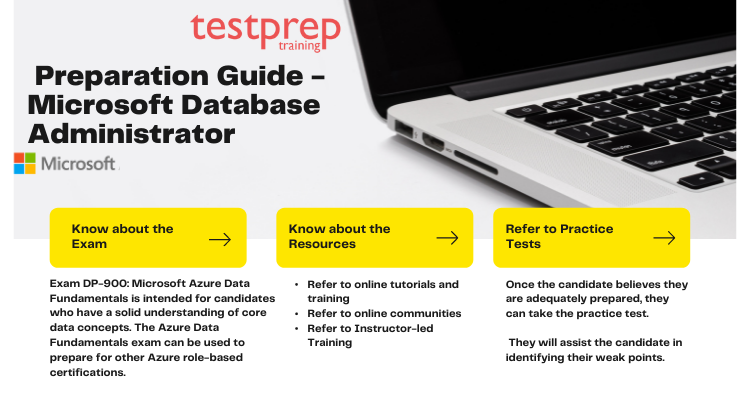It would be nearly impossible to analyze any of that data in a meaningful way without the database and the ability to query the database. It’s an exciting time in the data world, with new approaches to data collection, manipulation, and database types emerging. With this, we need gatekeepers and maintainers for all of these information treasure chests. A group of people who are commonly referred to as database administrators. Let us learn how can you become Microsoft Database Administrator?
What is a Database Administrator?
Exam DP-900: Microsoft Azure Data Fundamentals is intended for candidates who have a solid understanding of core data concepts. The Azure Data Fundamentals exam can be used to prepare for other Azure role-based certifications such as Azure Database Administrator Associate and Azure Data Engineer Associate.
Examinees must have the following knowledge:
- Candidates taking the Microsoft Azure DP-900 exam must understand how to use Microsoft Azure data services to implement core data concepts.
- They must be familiar with the concepts of relational and non-relational data, as well as various data workloads such as transactional or analytical.
- Candidates for this exam should begin working with cloud-based data.
Let us now move to the main point of the discussion –
Ultimate Guide to Becoming a Microsoft Database Administrator
First and foremost, familiarise yourself with all of the topics and subtopics covered in the exam syllabus. This will help you understand what you’ll need to learn and how you’ll organize your study time. Also, to pass the exam, follow these steps:

1. Know about the Exam Syllabus
This initial step is very important to get a complete idea about the exam –
Microsoft DP-900 Exam has updates in the course outline as on August 4, 2022.
The updated Microsoft DP-900 exam topics include:
1. Describe core data concepts (25—30%)
Describe ways to represent data
- Describe features of structured data (Microsoft Documentation: Understand data store models)
- Describe features of semi-structured (Microsoft Documentation: Query semi-structured data in SQL)
- Describe features of unstructured data (Microsoft Documentation: Understand data store models)
Identify options for data storage
- Describe common formats for data files (Microsoft Documentation: Data formats supported by Azure Data Explorer for ingestion)
- Describe types of databases (Microsoft Documentation: System Databases)
Describe common data workloads
- Describe features of transactional workloads (Microsoft Documentation: Online transaction processing (OLTP))
- Describe features of analytical workloads (Microsoft Documentation: Azure Cosmos DB analytical store)
Identify roles and responsibilities for data workloads
- Describe responsibilities for database administrators
- Describe responsibilities for data engineers (Microsoft Documentation: Data engineer)
- Describe responsibilities for data analysts
2. Identify considerations for relational data on Azure (20—25%)
Describe relational concepts
- Identify features of relational data (Microsoft Documentation: Describe concepts of relational data)
- Describe normalization and why it is used (Microsoft Documentation: Description of the database normalization basics)
- Identify common structured query language (SQL) statements (Microsoft Documentation: Structured Query Language (SQL))
- Identify common database objects (Microsoft Documentation: Database Identifiers)
Describe relational Azure data services
- Describe the Azure SQL family of products including Azure SQL Database, Azure SQL (Microsoft Documentation: Azure SQL, Azure SQL Database)
- Managed Instance, and SQL Server on Azure Virtual Machines (Microsoft Documentation: SQL Server on Windows Azure Virtual Machines)
- Identify Azure database services for open-source database systems (Microsoft Documentation: Azure SQL Database)
3. Describe considerations for working with non-relational data on Azure (15—20%)
Describing capabilities of Azure storage
- Describe Azure Blob storage (Microsoft Documentation: Azure Blob storage)
- Describe Azure File storage (Microsoft Documentation: Azure Files)
- Describe Azure Table storage (Microsoft Documentation: Azure Table storage)
Describe capabilities and features of Azure Cosmos DB
- Identify use cases for Azure Cosmos DB (Microsoft Documentation: Common Azure Cosmos DB use cases)
- Describe Azure Cosmos DB APIs (Microsoft Documentation: Azure Cosmos DB: REST API Reference)
4. Describe an analytics workload on Azure (25—30%)
Describing common elements of large-scale analytics
- Describe considerations for data ingestion and processing (Microsoft Documentation: Azure Data Explorer data ingestion overview)
- Describe options for analytical data stores (Microsoft Documentation: Choose an analytical data store in Azure)
- Describe Azure services for data warehousing, including Azure Synapse Analytics, Azure Databricks, Azure HDInsight, and Azure Data Factory (Microsoft Documentation: Data warehousing in Microsoft Azure, Azure Synapse Analytics)
Describe consideration for real-time data analytics
- Describe the difference between batch and streaming data (Microsoft Documentation: Explore fundamentals of real-time analytics)
- Describe technologies for real-time analytics including Azure Stream Analytics, Azure Synapse Data Explorer, and Spark structured streaming (Microsoft Documentation: Real-time processing)
Describe data visualization in Microsoft Power BI
- Identify capabilities of Power BI (Microsoft Documentation: Power BI)
- Describe features of data models in Power BI (Microsoft Documentation: Model data in Power BI)
- Identify appropriate visualizations for data (Microsoft Documentation: Visualization types in Power BI)
2. Understand the Exam Format
The Microsoft Azure Data Fundamentals DP-900 exam consists of 40-60 multiple-choice questions. When it comes to DP-900 exam questions, they can be of the scenario-based single answer type, multiple-choice type, arrange in the correct sequence type, drag & drop questions, mark review, drag and drop, and so on. However, to pass the exam, the DP-900 exam passing score must be 700 or higher. The examination fee, including taxes, is USD 99 to apply for the exam. Candidates can also take the exam in English, Japanese, Chinese (Simplified), Korean, French, German, or Spanish.
3. Is Microsoft Database Administrator a good career to explore?
Database administrators typically earn between $53,292 and $90,167 per year, according to PayScale. Salaries also differ depending on the industry, employer, and level of education. Entry-level professionals who obtain database administration-related certifications or degrees often advance more quickly in their careers.
Job opportunities and salaries also vary greatly depending on industry and location. The computer systems design and related services industry, for example, employs nearly twice as many database administrators as any other. Meanwhile, the nonresidential building construction, computer manufacturing, and oil and gas extraction industries pay the highest salaries for database administrators, closely followed by the auto manufacturing and finance industries.
Database administrator degree programs provide students with foundational skills and knowledge that can be applied to a variety of IT and CS careers. Computer systems analysts with the necessary programming skills can sometimes find work with only an associate degree; however, most network architects, computer programmers, and software developers require bachelor’s degrees as well as related certifications and work experience. Professionals in management positions at large corporations may also require master’s degrees.
Job opportunities and salaries also vary significantly by industry and location, with the majority of openings appearing in the computer systems design and related services industry and near major metropolitan areas. According to BLS data, database administrators made a median annual salary of $90,070 in 2018. In this field, higher education and certification typically increase salary potential.
4. Refer to the Learning Resources
Now that we have a thorough understanding of the exam syllabus as well as the scope of the exam, we can move on to the learning resources needed to pass the exam in one sitting!
Microsoft Learning Platform
The Microsoft learning platform will be a useful learning resource during exam preparation. However, make sure to visit Microsoft’s official website. To obtain authentic information about the DP-900 exam, it is best to first visit the Microsoft official website. You can easily find the DP-900 page and read through all of the necessary information about the DP-900 exam.
Microsoft Docs
Following that, you can proceed to Microsoft documentation to easily understand the Microsoft Azure Data Fundamentals exam concepts using the learning concepts that cover various modules. These Microsoft Docs modules will help you learn a lot about Azure data concepts and the various services available. The following are some of the DP-900 exam learning concepts:
- Firstly, Exploring core data concepts
- Secondly, Studying relational data in Azure
- Thirdly, Studying non-relational data in Azure
- Lastly, Exploring modern data warehouse analytics in Azure
Practice Tests
This is a critical component that will assist you in better preparing for the exam. That is to say, Microsoft DP-900 practice tests are important because they allow you to identify your weak and strong points. However, by practicing, you will be able to improve your answering skills and save a significant amount of time. Furthermore, the best time to begin doing practice tests is after you have completed one full topic, as this will serve as a revision component for you. As a result, make certain to locate the best practice sources.

Hurry up and try a free practice test for Microsoft Database Administrator now!

